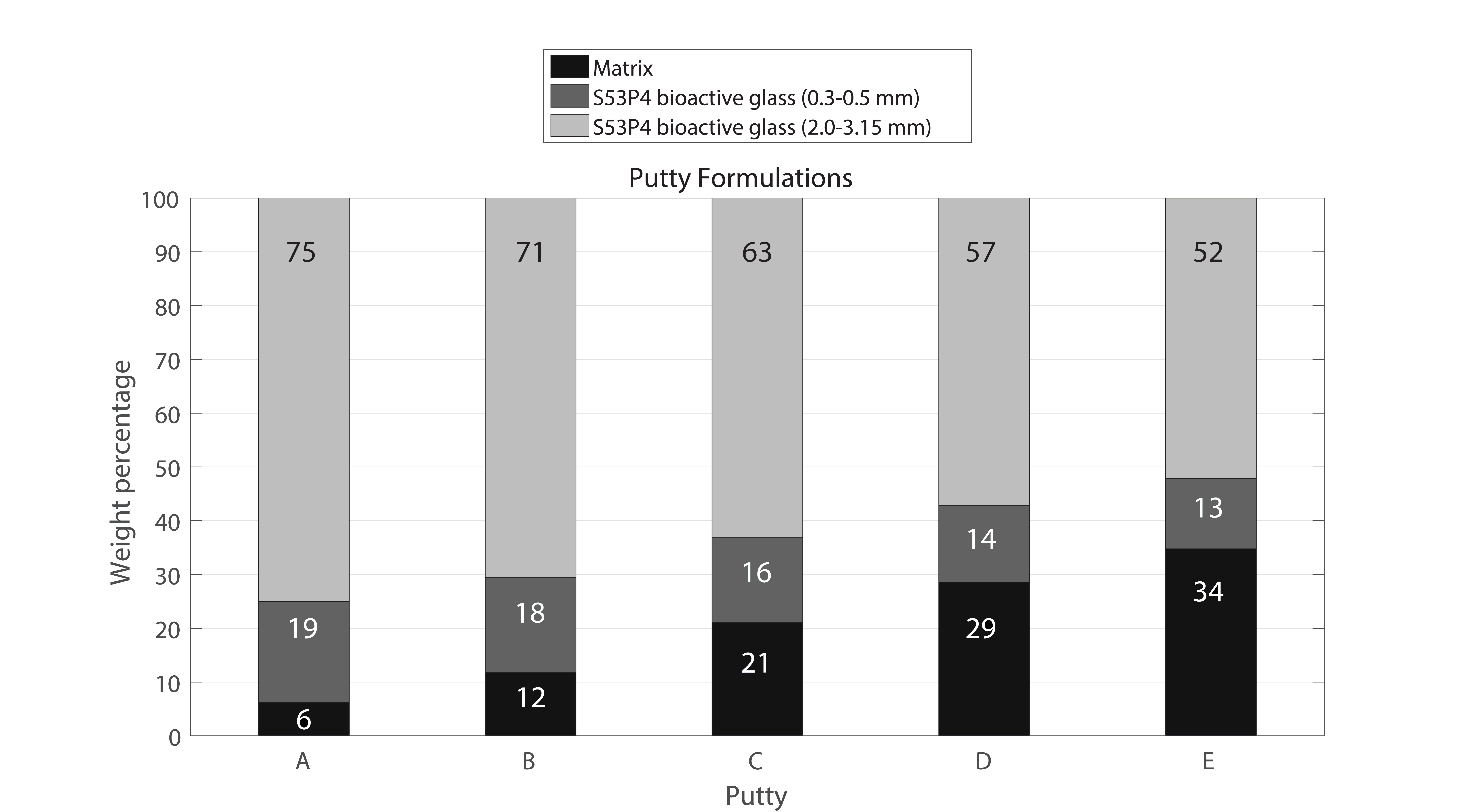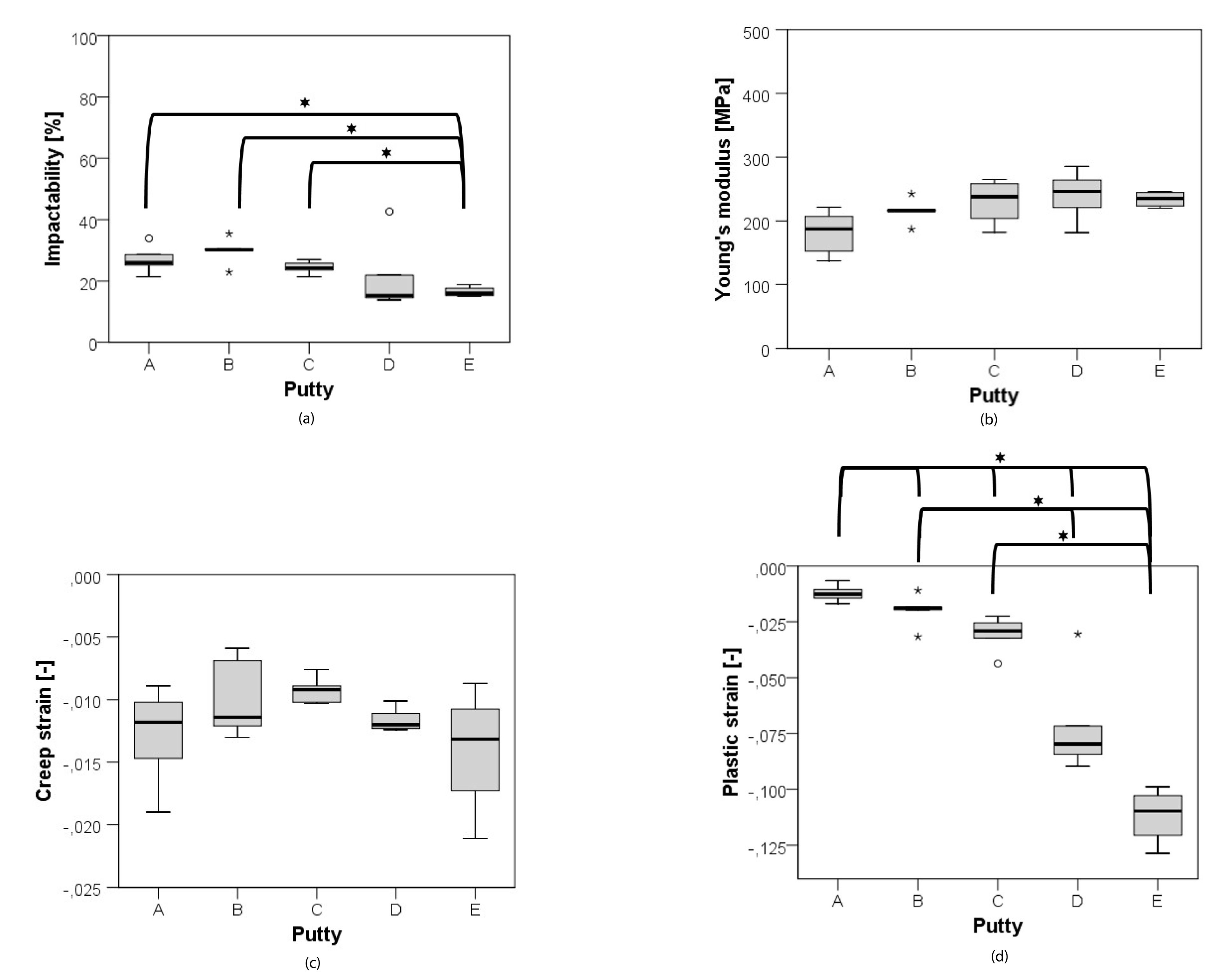Mechanical properties of bioactive glass putty materials
Nicole
Van Gestel1,
Jan
Geurts2,
Dennis
J.
Hulsen2,
Sandra
Hofmann1, 3, 4,
Keita
Ito1, 4,
Bert
Van Rietbergen1, 2 and
Jacobus
J.
Arts1, 2
-
1
Eindhoven University of Technology, Biomedical Engineering, Netherlands
-
2
Maastricht University Medical Centre, Orthopaedic Surgery, Netherlands
-
3
Swiss Federal Institute of Technology Zürich, Institute for Biomechanics, Switzerland
-
4
Eindhoven University of Technology, Institute of Complex Molecular Systems, Netherlands
Introduction: Bioactive glass (BAG) has been studied widely and seems to be a very promising biomaterial in regeneration of large bone defects and osteomyelitis treatment, because of its bone bonding and antibacterial properties[1]-[5]. Its high stiffness could potentially also enable mechanical reinforcement of large defects. The loose-granular nature of this material, however, makes it difficult to handle by the surgeon. Moreover, in previous research we found only sub-optimal mechanical properties for pure BAG fillings[6]. Recently a BAG putty was developed that is easier to handle. The aim of the current study is to determine the mechanical properties of this putty and its dependence on composition.
Materials and Methods: Five different compositions of S53P4 putty were tested in mechanical confined compression tests, after impaction of the samples (n=5 per group). The putty materials all consist of a synthetic binder (matrix: 20 wt% PEG 400, 40 wt% PEG 1500, 15 wt% PEG 3000 and 25 wt% glycerol), BAG granules (2.0-3.15 mm) and BAG powder (300-500 µm).

Figure 1.Compositions of the tested materials
Impaction was performed with the use of a custom-made impaction device (providing clinical relevant strains)[7]. After the samples were equally confined in PMMA chambers, they were subjected to 900 cycles of loading (40 – 850 N) followed by 300 s of rest. From the recorded displacement – time curves, the Young’s Modulus (elastic behaviour), plastic strains (permanent deformations) and creep strains (viscous behaviour) were determined and compared for the five compositions[7],[8].
Results and discussion: The results for impactability (measure for the height difference before and after impaction), Young’s Moduli, creep and plastic strain are shown in Figure 2. Significant differences between the putty compositions were found only for impactability and plastic strain.

Figure 2. Results of (a) impaction and confined compression tests (b) Young’s moduli representing elastic behaviour (c) Creep strain representing viscous behaviour and (d) Plastic strain representing permanent deformation behaviour
With an increasing amount of matrix the impactability decreases significantly. It has to be noted that the overall impactability is low, compared to graft materials such as morsellized cancellous bone or porous titanium[6],[7]. However, these materials are much less mouldable than the putty materials.
The Young’s moduli of all putty compositions were found to be in range of the modulus of cancellous bone (100-500 MPa), which is the desired range[9].
Furthermore, creep strains were low, which indicate that viscous behaviour will not likely affect the graft layer stability. The plastic strain increases with larger matrix content. Such plastic strain can threaten the graft stability in load-bearing applications and thus should be kept low.
Conclusion: For load bearing sites where the putty can be well confined in the defect, putty compositions with the low amount of matrix could be beneficial since their plastic strains are lowest. In other situations, the compositions with more matrix would be preferred because they are easier to handle.
Disclosure: This study was sponsored in kind (materials) by BonAlive® Biomaterials Ltd.
References:
[1] Ö. H. Andersson, G. Liu, K. H. Karlsson, L. Niemi, J. Miettinen, and J. Juhanoja, “In vivo behaviour of glasses in the SiO2-Na2O-CaO-P2O5-Al2O3-B2O3 system,” J. Mater. Sci. Mater. Med., vol. 1, no. 4, pp. 219–227, Nov. 1990.
[2] E. Munukka, O. Leppäranta, M. Korkeamäki, M. Vaahtio, T. Peltola, D. Zhang, L. Hupa, H. Ylänen, J. I. Salonen, M. K. Viljanen, and E. Eerola, “Bactericidal effects of bioactive glasses on clinically important aerobic bacteria.,” J. Mater. Sci. Mater. Med., vol. 19, no. 1, pp. 27–32, Jan. 2008.
[3] O. Leppäranta, M. Vaahtio, T. Peltola, D. Zhang, L. Hupa, M. Hupa, H. Ylänen, J. I. Salonen, M. K. Viljanen, and E. Eerola, “Antibacterial effect of bioactive glasses on clinically important anaerobic bacteria in vitro,” J. Mater. Sci. Mater. Med., vol. 19, no. 2, pp. 547–51, Feb. 2008.
[4] N. C. Lindfors, I. Koski, J. T. Heikkilä, K. Mattila, and A. J. Aho, “A prospective randomized 14-year follow-up study of bioactive glass and autogenous bone as bone graft substitutes in benign bone tumors,” J. Biomed. Mater. Res. - Part B Appl. Biomater., vol. 94, no. 1, pp. 157–164, Jul. 2010.
[5] L. Drago, D. Romanò, E. De Vecchi, C. Vassena, N. Logoluso, R. Mattina, and C. L. Romanò, “Bioactive glass BAG-S53P4 for the adjunctive treatment of chronic osteomyelitis of the long bones: an in vitro and prospective clinical study.,” BMC Infect. Dis., vol. 13, no. 1, pp. 584–592, Jan. 2013.
[6] D. J. W. Hulsen, J. Geurts, N. A. P. van Gestel, B. Van Rietbergen, and J. J. C. Chris Arts, “Mechanical properties of Bioactive Glass granules and morselized cancellous bone allograft in load bearing defects.,” J. Biomech., vol. Submitted, 2015.
[7] L. H. B. Walschot, B. W. Schreurs, P. Buma, and N. Verdonschot, “Impactability and time-dependent mechanical properties of porous titanium particles for application in impaction grafting,” J. Biomed. Mater. Res. - Part B Appl. Biomater., vol. 95, no. 1, pp. 131–140, 2010.
[8] N. Verdonschot, C. T. H. Van Hal, B. W. Schreurs, P. Buma, R. Huiskes, and T. J. J. H. Slooff, “Time-dependent mechanical properties of HA/TCP particles in relation to morsellized bone grafts for use in impaction grafting,” J. Biomed. Mater. Res., vol. 58, no. 5, pp. 599–604, 2001.
[9] B. D. Ratner, A. S. Hoffmann, F. J. Schoen, and J. E. Lemons, Eds., Biomaterials Science, 3th ed. Oxford: Elsevier Inc., 2012.
Keywords:
biomaterial,
clinical application,
mechanical property,
Bone graft
Conference:
10th World Biomaterials Congress, Montréal, Canada, 17 May - 22 May, 2016.
Presentation Type:
General Session Oral
Topic:
Mechanical properties of biomaterials
Citation:
Van Gestel
N,
Geurts
J,
Hulsen
DJ,
Hofmann
S,
Ito
K,
Van Rietbergen
B and
Arts
JJ
(2016). Mechanical properties of bioactive glass putty materials.
Front. Bioeng. Biotechnol.
Conference Abstract:
10th World Biomaterials Congress.
doi: 10.3389/conf.FBIOE.2016.01.01368
Copyright:
The abstracts in this collection have not been subject to any Frontiers peer review or checks, and are not endorsed by Frontiers.
They are made available through the Frontiers publishing platform as a service to conference organizers and presenters.
The copyright in the individual abstracts is owned by the author of each abstract or his/her employer unless otherwise stated.
Each abstract, as well as the collection of abstracts, are published under a Creative Commons CC-BY 4.0 (attribution) licence (https://creativecommons.org/licenses/by/4.0/) and may thus be reproduced, translated, adapted and be the subject of derivative works provided the authors and Frontiers are attributed.
For Frontiers’ terms and conditions please see https://www.frontiersin.org/legal/terms-and-conditions.
Received:
27 Mar 2016;
Published Online:
30 Mar 2016.